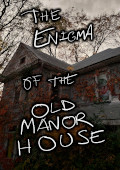The Enigma of the Old Manor House — 13 of 28
Daniel M. Stelzer
Part Study
The Study is a room. "[if there should be darkness]This room feels small and bare, the sort of place meant for a single person to do work. The carpet is soft under your feet[else]This room feels comfortable and uncomfortable at the same time. The carpet is soft under your feet, and it's all arranged in a way that feels nice and home-y[--]but at the same time, something is missing. All the little decorations and possessions that would make this [i]someone's[/i] study in particular are gone, leaving a sort of empty shell behind[end if]."
The old carpet is scenery in the Study. The description is "Old and stained, but still nice and soft." Understand "stained" or "nice" or "soft" as the carpet.
An old desk is fixed in place in the Study. "An old, well-worn desk stands in one corner, lit by a single square of moonlight coming through the skylight[if there should be light]. It looks like it would be a good place to work if it had a proper chair[else]. Everything except the top is invisible in the darkness[end if]." The description of the desk is "It's an odd sort of pentagon shape, designed to fit into the corner and extend a bit along each wall[if there should be light]. The way the drawers are arranged is probably supposed to make them easy to reach[end if]."
The top of the desk is an enterable supporter. It is part of the old desk.
Some desk drawers is a closed openable lightbound container. They are part of the old desk. Understand "drawer" as the drawers.
Before climbing or entering the desk: try entering the top of the desk instead.
Before putting something on the desk: try putting the noun on the top of the desk instead.
Before inserting something into the desk when the drawers are scopable: try inserting the noun into the drawers instead.
Before opening the desk when the drawers are scopable: try opening the drawers instead.
Before closing the desk when the drawers are scopable: try closing the drawers instead.
Instead of opening or closing the desk: say "It probably has a drawer or something, but you can't find it in the dark."
A tiny silver key is a key in the desk drawers. The plural of key is asdfasdf.
Before searching the old desk:
if there should be light:
say "(searching the top)[command clarification break]";
try searching the top of the desk;
say "(searching the drawers)[command clarification break]";
try searching the desk drawers;
stop the action;
otherwise:
say "(feeling around the top)[command clarification break]";
try searching the top of the desk;
stop the action.
A study-skylight is an inside-skylight in the Study. It leads to the Roof. It is scenery. The description is "Placed just right to illuminate the desk, and maybe let in some fresh air."
A grandfather clock is a lightbound container in the Study. "A grandfather clock is placed against the opposite wall." It is closed, locked, openable, and fixed in place. The tiny silver key unlocks it. The description of the clock is "It's not ticking any more; the hands have stopped forever at 7:30. The front of the case is currently [if closed]closed[else]open[end if]."
Instead of opening the locked clock: say "You tug on the case, but nothing happens. Looking closer, there seems to be a tiny keyhole under the face."
After opening the clock: say "You pull the front of the clock open, revealing the pendulum inside. The movement makes it rock from side to side and the clock ticks loudly for a few seconds."
Understand "face" or "case" or "front" or "hands" or "hand" or "keyhole" or "tiny keyhole" as the clock.
The pendulum is fixed in place in the clock. The description is "It hangs still and silent."
Instead of pushing or pulling or turning the pendulum: say "You give it a shove and it ticks loudly for a few seconds before falling still again."
